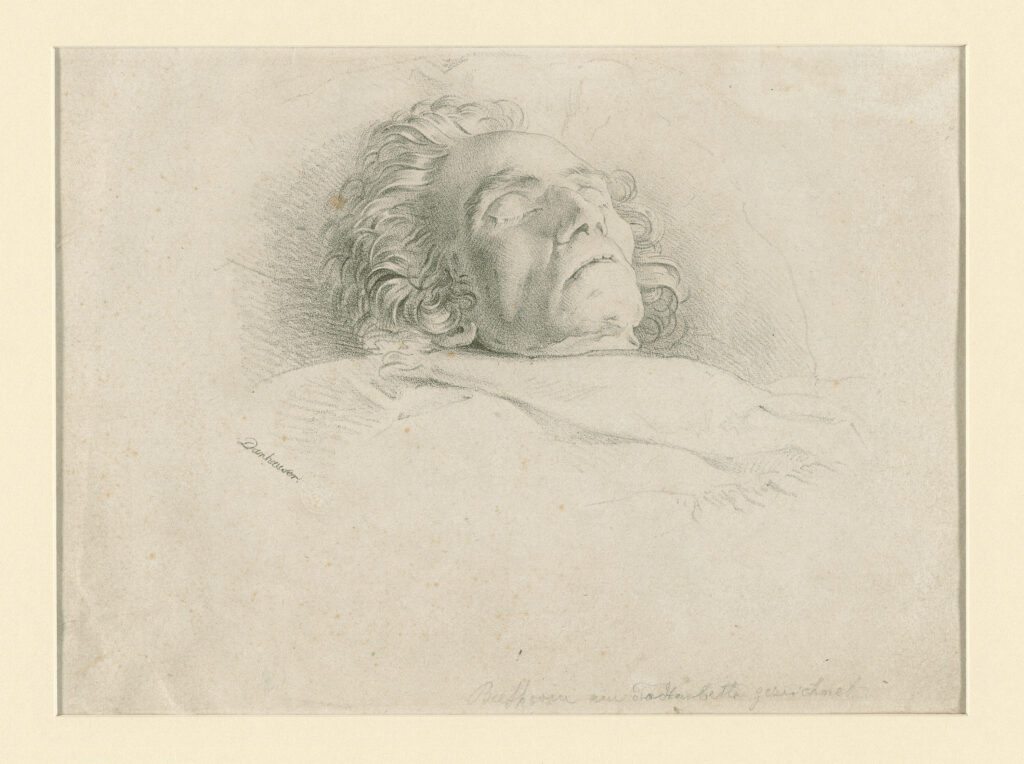Preface by William Meredith
One of the most important mysteries in Beethoven’s biography has been what caused his death from liver failure and kidney disease. Thanks to the tremendous work of the team of 32 scientists and musicologists of the Beethoven Genome Project, we now know much more than we did about the complexities of the causes of his liver disease. I asked the lead author of the genome paper, Tristan Begg, to explain the three new important findings, which complicate but at the same time deepen our understanding. As you can read below in Begg’s statement, Beethoven’s alcohol consumption played some role in his cirrhosis. In order to gain some clarity on the issue of how much Beethoven drank during his last decade, I asked the translator and editor of the new English edition of Beethoven’s conversation books, Theodore Albrecht, to give us his assessment: “In the days before Vienna’s crystal-clear tap water was piped from the Schneeberg (Snow Mountain), 40 miles south, the only reasonably safe drinks were fermented wine and beer and boiled coffee. In his routine daily schedule, Beethoven drank coffee while he worked through the morning, drank wine with mid-day dinner, drank coffee while reading the daily newspapers at a cafe in the late afternoon, and had a glass of wine or beer with his light evening supper at home. Like virtually all Viennese, he kept a stock of wine at home and kept an eye out for the best wine bargains in the newspapers. In none of these activities did Beethoven exceed the line of consumption that would make him an ‘alcoholic,’ as we would commonly define it today. His activities as documented in the conversation books from 1818 to 1827 and his correspondence do not document any excesses in this area beyond a few convivial social occasions. If Beethoven had an inherited sensitivity to alcohol that would render him especially susceptible to disease resulting from any ingestion of alcohol whatsoever, that is an entirely different factor that must be considered separately—and is being done so in this case.” (March 15, 2023)
Hepatitis as a cause of cirrhosis has been missing in some medical studies but favored in a few. The standard text on the composer’s illnesses is Peter J. Davies’s monograph, Beethoven in Person: His Deafness, Illnesses and Death (Westport, Connecticut: Greenwood Press, 2001). There he concluded that Beethoven’s death was caused by “renal papillary necrosis and liver failure” (see chapter 15 on “The Cause of Beethoven’s Death,” pp. 207-16). As one measure of the importance of the discovery of hepatitis in the Stumpff Lock, the disease is not even listed in Davies’s index. Hepatitis is discussed briefly in François Martin Mai’s valuable monograph Diagnosing Genius: The Life & Death of Beethoven (Montreal: McGill-Queen’s University Press, 2007; see pp. 140, 150). Mai wrote: “There is a possibility that Beethoven’s condition [cirrhosis] was caused by post-viral hepatitis. The six-week episode of jaundice that occurred in 1821 may also have been caused by a virus. This episode cleared completely, leaving the liver damaged but still functioning. … Three of the authors named above—Ober [1970], Larkin [1985], and Keynes [2002]—favour post-viral hepatitis as the cause of his cirrhosis” (p. 140). Mai concluded, “Since hepatitis is diagnosed by carrying out biochemical tests and biopsy studies, it is not possible to prove or to disprove, at this juncture, that Beethoven’s cirrhosis was post-viral” (p. 140). The significance of the hepatitis discovery is discussed below by the genome’s lead author, Tristan Begg.
Tristan Begg on Beethoven’s Liver Disease Risk Factors
The Beethoven Genome Project revealed three additional liver disease risk factors previously unknown, or unproven, to medical biographers. These comprise two sets of heritable risk factors, primarily in Beethoven’s PNPLA3 gene and to a lesser extent in his HFE gene, and one infectious risk factor, hepatitis B virus (HBV). Each of these requires care when interpreting.
Beethoven’s heritable risk factors would not have posed any meaningful risk for liver disease on their own, but they become relevant to his history of liver disease owing to a well-documented interaction with alcohol consumption. The extent of this interaction would have depended greatly on his alcohol consumption, which is impossible to accurately quantify from the documentary evidence, but which may someday be scientifically testable. To best interpret this and to quantify Beethoven’s risk for developing liver disease, retrospective cohort analyses were performed using data from the UK BioBank. The liver disease and cirrhosis prevalences among different alcohol-consuming male cohorts in the UKBioBank, who share Beethoven’s genetic risk factors and had a similar age at recruitment to Beethoven’s age at death, varied considerably, depending on how much alcohol they were regularly consuming. Surprisingly low disease prevalences were observed even among the heaviest self-reported drinkers, while higher prevalences were observed among men diagnosed with one of two alcohol use disorders (approximately 1 in 5 were diagnosed with cirrhosis by the approximate age of Beethoven’s death).

As the extent of Beethoven’s alcohol consumption is not known with certainty, and a decided majority of his contemporaries claimed that for most of his life it was either moderate, or very moderate by early 19th-century Viennese standards, a definite interpretation of the interaction between heritable risk and alcohol cannot yet be arrived at.
Even if Beethoven’s alcohol consumption was generally considered moderate by contemporary standards, it was still likely harmful, and likely interacted with his genetic risk to induce an even greater degree of harm to his liver. Despite this, alcohol alone is a less plausible explanation for Beethoven’s first attack of jaundice. Acute alcoholic hepatitis usually represents very severe liver disease and has a poor prognosis, particularly if the patient does not cease drinking, as well as among individuals with elevated genetic risk. After his first attack of jaundice in the summer of 1821, Beethoven would exhibit no further definite signs of liver disease for at least three and a half years, with no discernible difference in his drinking habits upon the resumption of the conversation books in May of 1822, save for a period between the summers of 1825 and 1826 when it appears to have increased during his close friendship with Karl Holz.
Concerning the further progression of his liver disease, definitely noted by 1825, the interaction between alcohol and heritable risk very plausibly played a role; we cannot say how significant. It is nonetheless probably no coincidence that the period of increased drinking with Karl Holz almost immediately preceded Beethoven’s terminal bout of liver disease.
The difficulties in fitting Beethoven’s first attack of jaundice in 1821 solely to the interaction between alcohol and genetic risk do invite serious consideration of an additional major risk factor for liver disease identified in this study: Hepatitis B virus, or HBV. HBV presents a similarly complex picture to alcohol and is at a similar risk of being misinterpreted. Great care must be taken attempting to interpret the HBV analyses, particularly as they are the first of their kind in the world. Only the Stumpff Lock was positive for HBV; however, this was the best preserved lock, from which the greatest amount of material was extracted, and which was prepared for sequencing with the most efficient methods.
Taking these factors into account, when we look at the earlier locks of hair also tested, we can by no means assert that we have sufficient sensitivity to claim that Beethoven was HBV-negative at the time those hairs were forming. Sensitivity analyses revealed that as little as a 10-fold reduction in viremia would have wiped out any signal in the earlier three locks, and HBV viremia is known to fluctuate randomly and dramatically, by 2-3 orders of magnitude, at times appearing entirely absent. We therefore cannot claim to have sufficient margins to draw any conclusions from these negative results.
Hepatitis B infections can be either acute or chronic. In acute infections, there is usually a brief and often asymptomatic period of infection that tends to be cleared in adults, though in a significant faction of cases, jaundice will be present for a period of weeks to months. Chronic infections are typically acquired at birth or in early childhood, and can be dormant for years or decades, presenting in acute flare-ups of hepatitis (i.e. jaundice) and resulting in a considerably increased lifetime risk for cirrhosis and liver cancer. We cannot say definitely whether the HBV infection we observed was chronic or acute, but several factors favor a chronic infection. The first of these is epidemiology: The great majority of ongoing HBV infections in the world are chronic in nature. If HBV DNA is detected in a lock of hair, it will usually be due to a chronic infection. The second factor is sampling methodology: Among the locks tested, we randomly sampled 4 very brief transects of Beethoven’s life; the probability of sampling a short lock of hair that would have coincided with the typically brief period of high HBV-replication in an acute infection is, contrasted against Beethoven’s 56 years, akin to finding a needle in a haystack. And finally there is the consistency with Beethoven’s symptoms: Beethoven’s attack of jaundice in 1821 is perfectly consistent with either the acquisition of an acute HBV infection, or a flare-up of a chronic HBV infection. The serious qualifications that apply to the scenario of acute alcoholic hepatitis, mentioned above, do not apply in the case of HBV—only in rare cases does acute illness with HBV lead to lethal fulmination.
One of the few statements about Beethoven’s HBV infection that can be made with reasonable certainty is that it would have been active in the months leading to his final illness, as the Stumpff Lock hairs most likely represent a period of growth dating to at least spring to winter of 1826. None of the common infection scenarios for HBV, including perinatal transmission, childhood transmission, percutaneous transmission, and infection via sexual contacts, have strong support. However, adult infection scenarios are less likely than perinatal or early childhood infection scenarios, as 90-95% of adults clear acute infections and gain immunity. It is therefore quite probable, though by no means certain, that Beethoven’s infection would have been lifelong, and dormant for most of his life.
What is the configuration of these major risk factors for liver disease, in light of Beethoven’s history of deteriorating liver health? At present, no one can say for certain, though the authors of the study look forward to a lively and healthy debate over the plausibility of various hypotheses.
